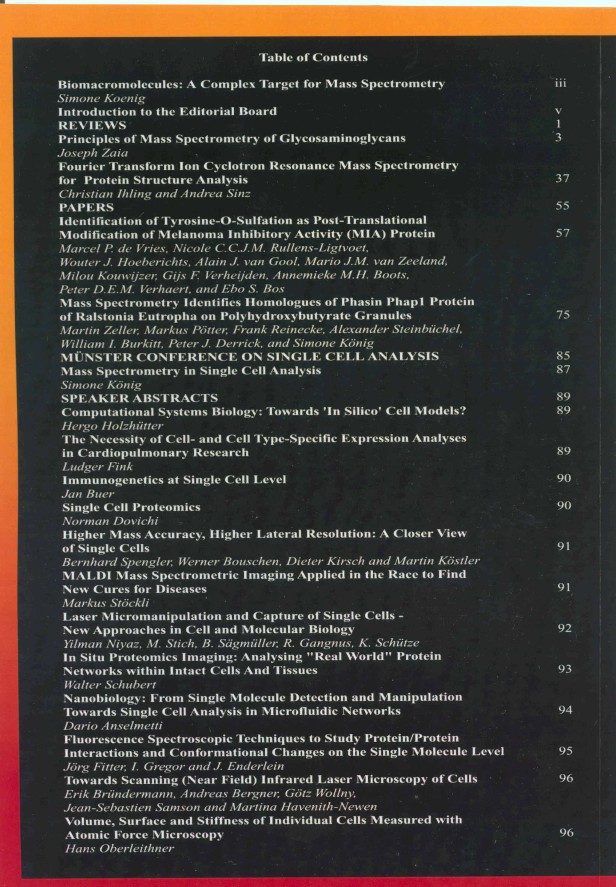Identification of tyrosine-O-sulfation as post-translational modification of melanoma inhibitory activity (MIA) proteinMarcel P. de Vries, Nicole C.C.J.M. Rullens-Ligtvoet, Wouter J. Hoeberichts, Alain J. van Gool, Mario J.M. van Zeeland, Milou Kouwijzer, Gijs F. Verheijden, Annemieke M.H. Boots, Peter D.E.M. Verhaert, and Ebo S. Bospp 57-73Abstract:Matrix assisted laser desorption ionization time-of-flight mass spectrometry (MALDI-TOF MS) and isoelectric focusing (IEF) of pure recombinant human MIA (melanoma inhibitory activity) protein, as expressed in CHO cells, indicated that part of the protein was post-translationally modified. Whereas standard positive ion mode MALDI analysis of intact MIA revealed an additional peak 80 Da higher than the theoretical mass, IEF showed three major protein bands which could all unequivocally be identified as MIA isoforms by peptide mass fingerprinting. Negative ionization MALDI mass spectrometry on a quadrupole TOF instrument indicated that the differences between these isoforms were due to one or two 80 Da modifications confined to tryptic fragment 59-76. The identity of the 80 Da post-translational modification (PTM) was determined to be a Tyr-O-sulfation through enzymatic removal of the 80 Da moiety from MIA by arylsulfatase treatment, and through the absence of the 80 Da modification(s) in MIA harvested from cells cultured in the presence of chlorate, which is known to inhibit Tyr-O-sulfation. The PTM being sulfation was further corroborated by its metastability upon MALDI-TOF MS analysis. It is concluded that the CHO produced MIA is partially post-translationally modified by Tyr-O-sulfation at positions 69 and/or 70 (59LFWGGSVQGDYYGDLAAR76). Protein Tyr-O-sulfation, has been reported to serve various functions, including modulation of protein-protein interactions. Combination of this notion with the observation that the eukaryotic MIA protein shows only a weak binding towards laminin and fibronectin leads to the speculation that the putative in vivo metastasis promoting activity of MIA may be based on the interaction of MIA with an as yet unknown factor via Tyr-(O)-sulfation enhanced binding kinetics.Mass spectrometry identifies homologues of phasin Phap1 protein of Ralstonia Eutropha on polyhydroxybutyrate granulesMartin Zeller, Markus Pötter, Frank Reinecke, Alexander Steinbüchel, William I. Burkitt, Peter J. Derrick, and Simone Königpp 75-84Abstract:Many prokaryotes use polyhydroxyalkanoates (PHA) as storage compounds for carbon and/or energy in the form of water-insoluble inclusion PHA granules in the cytoplasm. The surface of such granules is covered by proteins which also affect their form and structure. Here, phasin PhaP1 protein was identified in high abundance on the grana surface of R. eutropha employing gel electrophoretic separation and mass spectrometry. Homologous phasins PhaP3 and Pha4 were visualized using 2D-PAGE in the PhaP1 knock-out mutant, but no evidence for the presence of PhaP2 could be found. All detected phasins exhibit isoforms whose structural differences are still a matter of investigation, although C-terminally truncated isoforms of PhaP1 were detected with FTICR-MS.
